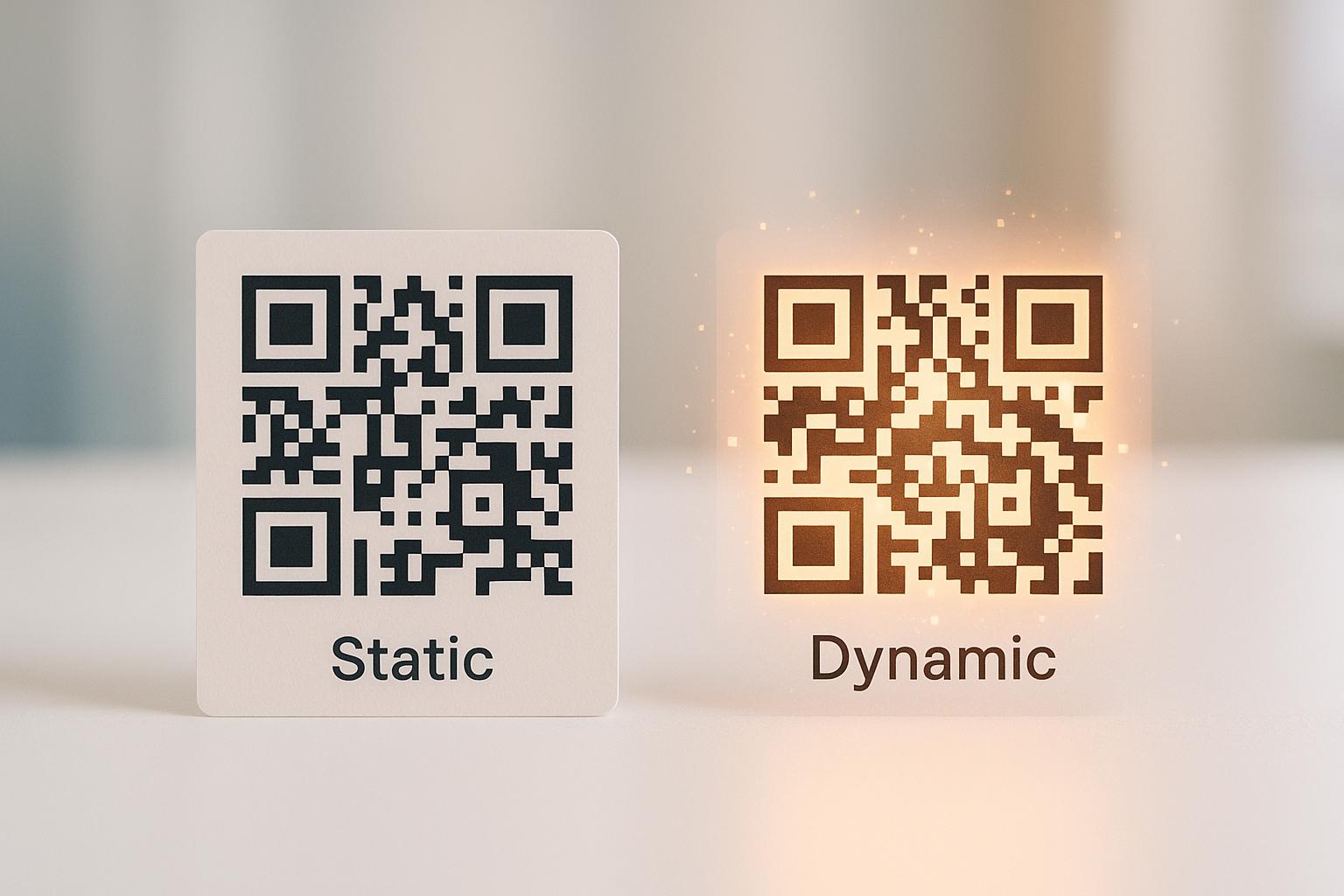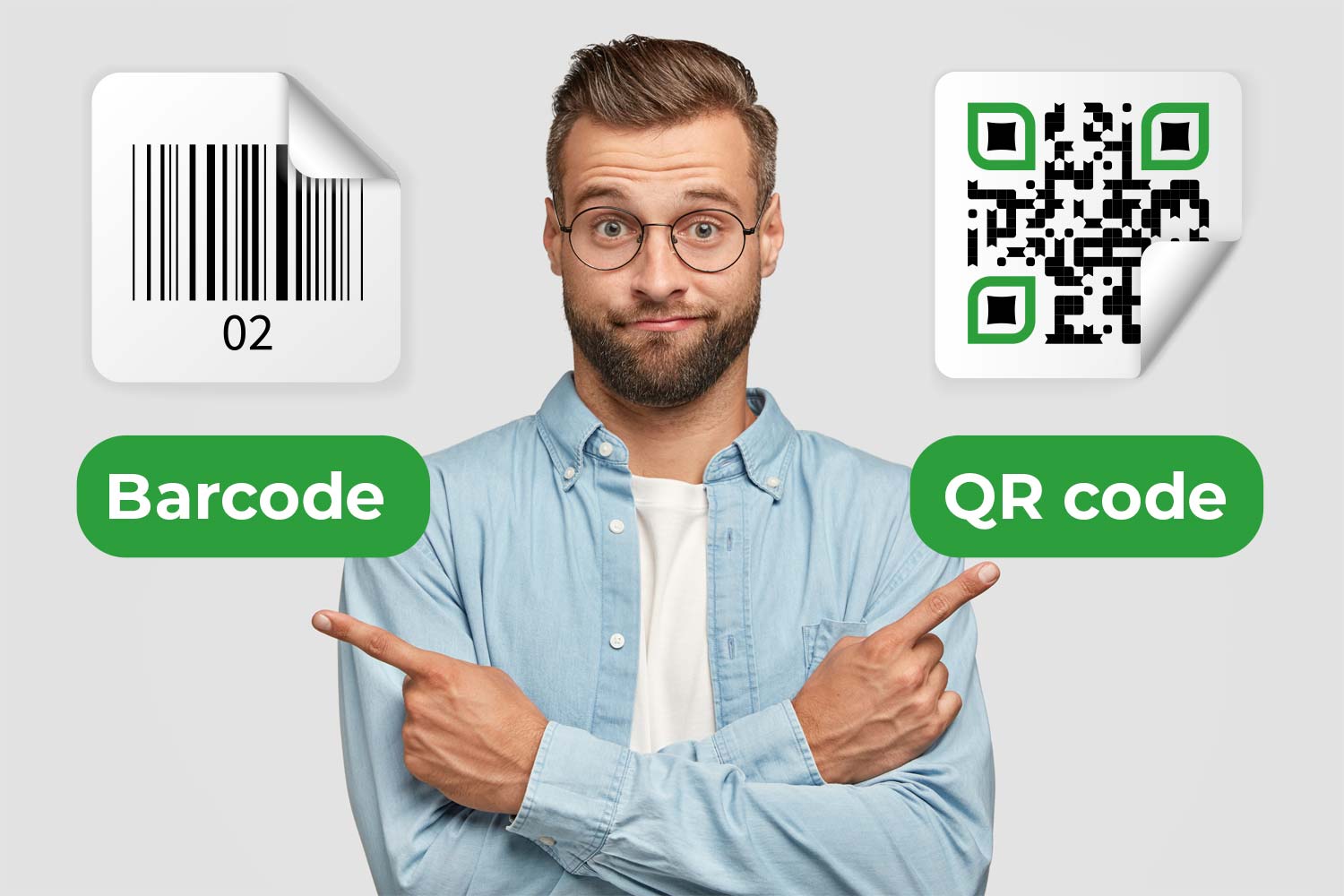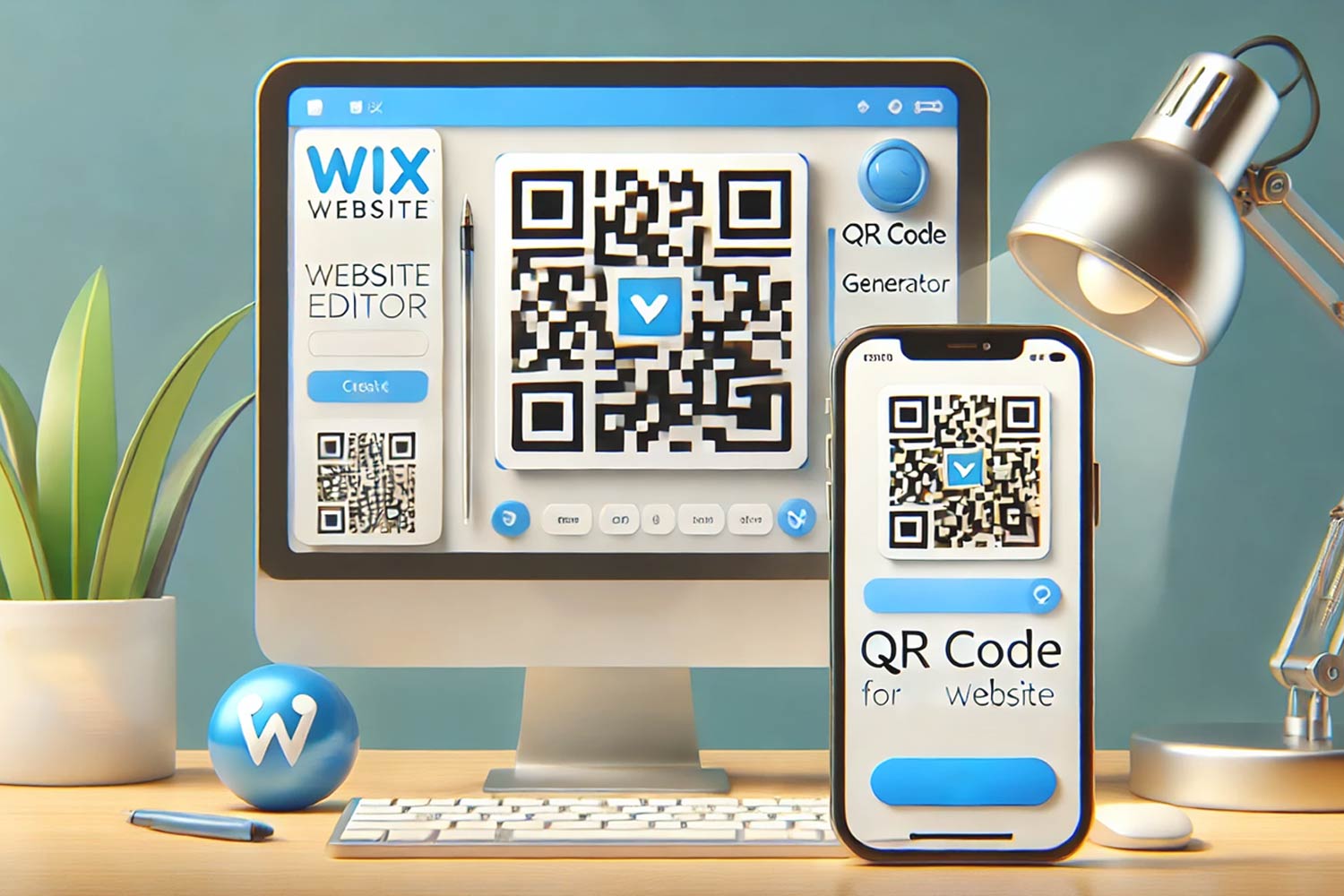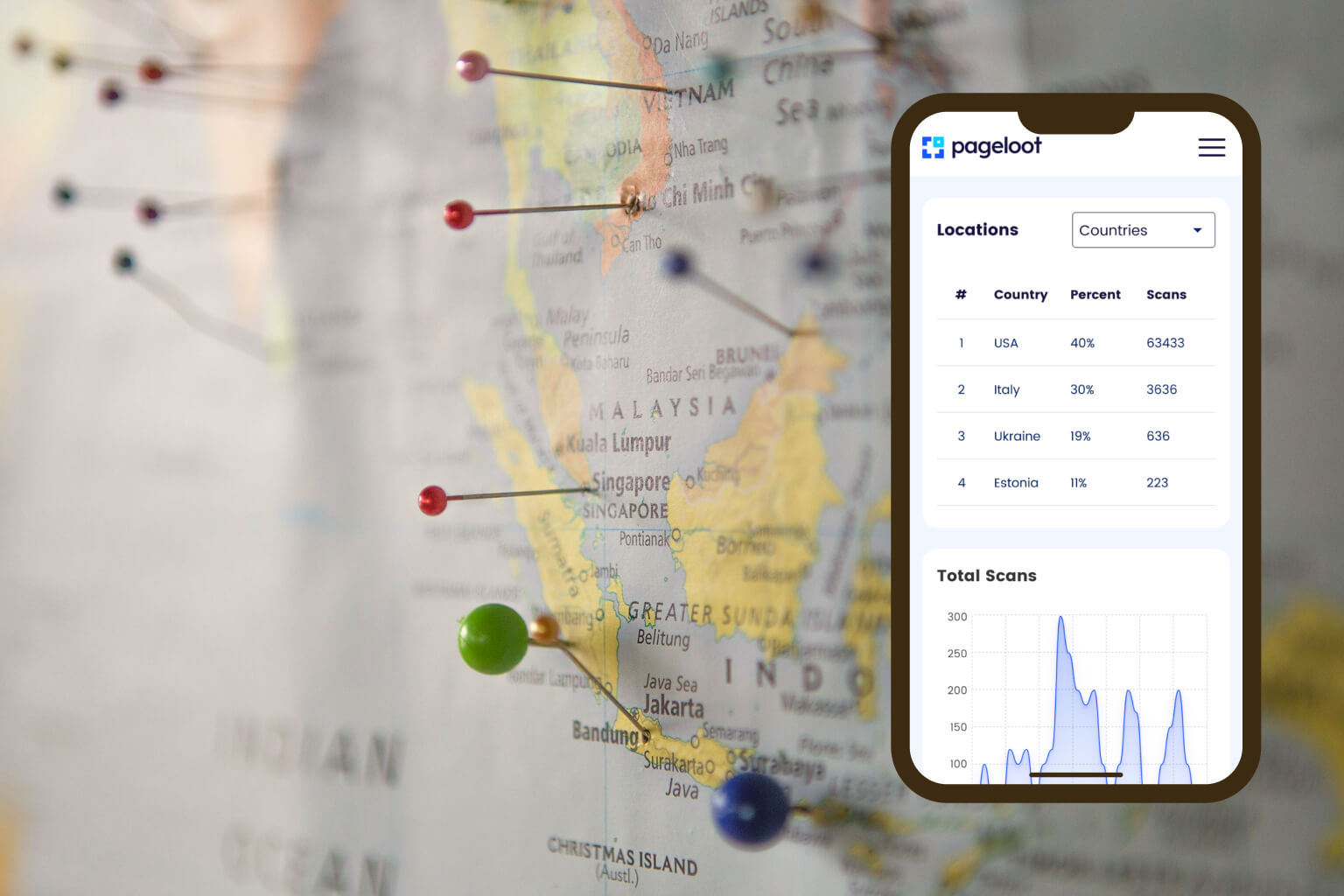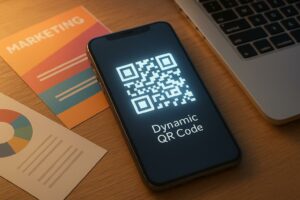QR codes are everywhere, but not all QR codes are the same. The two main types – static ja dünaamiline – serve different purposes and have unique features. Here’s a quick breakdown:
- Staatilised QR-koodid: Fixed information that can’t be changed after creation. Best for permanent details like Wi-Fi passwords or product info. No tracking or analytics.
- Dünaamilised QR-koodid: Flexible and editable even after printing. Includes tracking, analytics, and customization options. Ideal for marketing campaigns, menus, and events.
Quick Comparison
| Funktsioon | Staatilised QR-koodid | Dünaamilised QR-koodid |
|---|---|---|
| Redigeeritavus | Cannot be changed | Can be updated anytime |
| Jälgimine | No analytics | Detailed scan analytics available |
| URL Structure | Long and complex | Short and simple |
| Skaneerimise kiirus | Slower | Faster |
| Kulud | Free, but requires reprints | Subscription-based, saves reprints |
| Kasutusjuhtumid | Permanent info (e.g., Wi-Fi) | Marketing, menus, campaigns |
Key takeaway: Use static codes for unchanging info and dynamic codes for flexibility, tracking, and long-term campaigns.
Staatilised vs dünaamilised QR-koodid
What is a static QR code
A static QR code is a type of two-dimensional barcode that holds data directly within its design. This data – whether it’s a website link, contact information, or plain text – remains fixed and cannot be altered after the code is created. Scanning the code instantly reveals the embedded information.
Definition and characteristics
Static QR codes permanently store their data in the visual pattern of the code. Once created, the information cannot be updated, which sets them apart from dynamic QR codes that allow for edits and changes.
Globally, up to eight QR codes are generated every minute, and according to a Uniqode report, QR code creation has surged by four times between 2021 and 2024.
Because of their fixed nature, static QR codes are best suited for sharing information that doesn’t need updates or changes.
Common use cases
Static QR codes are perfect for situations where the information remains consistent over time. Here are some popular applications:
- Business networking: Adding static QR codes to visiitkaardid allows professionals to share contact details like phone numbers, emails, or LinkedIn profiles. Scanning the code can save this information directly to a device.
- Product information: Many companies include static QR codes on product packaging to provide details like ingredients, usage instructions, or safety warnings. It’s an efficient and cost-effective way to share essential product information.
- Educational resources: In schools or universities, static QR codes can link students to study materials, textbooks, or reference guides, offering an easy way to access additional learning resources.
- Wi-Fi access: Sharing Wi-Fi passwords becomes simpler with static QR codes. These are often used in homes, offices, or kohvikud, allowing guests to connect to the network quickly by scanning the code. You can create one using a Wi-Fi QR code generator.
Limitations of static QR codes
While static QR codes are simple and inexpensive, they come with a few notable downsides:
- No editing capability: Once a static QR code is generated, it cannot be changed. If the URL or data linked to the code is incorrect or becomes outdated, a new QR code must be created.
- No tracking features: Static QR codes don’t support analytics. You won’t be able to track data like the number of scans, user locations, or the types of devices used.
- Scanning challenges with complex data: The more data embedded in the code, the denser the pattern becomes. This can make the code more difficult and slower to scan.
- Limited marketing options: Static QR codes are not suitable for online retargeting or time-sensitive campaigns due to their inability to adapt or provide analytics.
For campaigns requiring flexibility, tracking, or frequent updates, switching to a dünaamiline QR-koodi generaator is a better choice.
What is a dynamic QR code

A dynamic QR code is a more advanced version of the traditional QR code. Instead of directly encoding static information, it embeds a short URL that redirects users to the desired content. The standout feature? You can update or modify the destination link even after the QR code has been printed or shared.
"Dynamic QR codes send users on to specific information or web pages, just like any other QR code. What makes them ‘dynamic’ is that the URL encoded in them redirects to a second URL that can be changed on demand, even after a code is printed. Static QR codes can’t be changed in that way."
When someone scans a dynamic QR code, it reads the short URL and redirects them to the destination you’ve set. This ability to change the linked content without needing to reprint the code makes it incredibly versatile.
Definition and characteristics
Dynamic QR codes work by embedding a short URL (e.g., qrco.de) that serves as a bridge to the actual content. This setup allows for flexibility, as you can modify the destination at any time without needing a new code.
What makes dynamic QR codes stand out is their adaptability. You can update the linked content, correct errors, or even redirect users to entirely different destinations while keeping the same printed code. This is especially useful for campaigns that require frequent updates or have a long lifespan.
Another advantage is their cleaner design. Dynamic codes often have simpler patterns compared to static ones, especially when linking to long URLs. This makes them faster to scan and visually less cluttered, improving the user experience.
Advanced features
Dynamic QR codes come packed with features that make them ideal for businesses and organizations:
- Scan tracking and analytics: These codes provide data on how many people scanned them, when and where the scans occurred, and even details about the devices used. This information helps businesses evaluate the success of their campaigns and refine their strategies.
- Content editing: Need to fix a typo, update a menu, or change a URL? Dynamic QR codes let you edit the linked content anytime through a management platform, avoiding the hassle and cost of reprinting.
- Smart redirection: With this feature, you can direct users to different destinations based on their device type, location, or the time of day. For instance, iPhone users can be sent to the App Store, while Android users are redirected to Google Play.
- Password protection: Add a layer of security to your QR codes, ensuring only authorized users can access the content. This is especially useful for sensitive company materials or exclusive offers.
- Scheduled campaigns: Set up different destinations for specific time periods. For example, you can promote one product in the morning and switch to another in the evening without manual updates.
Common use cases
Thanks to their flexibility and advanced features, dynamic QR codes are used in a variety of scenarios:
- Turunduskampaaniad: Dynamic codes allow marketers to track engagement and adjust strategies in real-time. For example, Lionsgate used dynamic QR codes in 2024 for localized film promotions, achieving over 12,000 engagements across 65 cities.
- Restaurants and hospitality: Dynamic QR codes are a game-changer for menus. In 2020, Marriott Aruba replaced printed menus with QR codes, saving around $150,000 in printing costs. They could update menu items and prices instantly, simplifying seasonal changes.
- Event management: Event organizers use dynamic QR codes to update schedules, venue details, or speaker information without reprinting materials. They can also track attendance and engagement through scan analytics.
- Toote pakend: Businesses use dynamic QR codes on packaging to link customers to up-to-date product details, instructional videos, or warranty information. This also helps track which products are generating the most interest.
- Education and museums: Educational institutions and cultural spaces like Hong Kong’s M+ museum use dynamic QR codes to share evolving course materials or exhibit details. The museum saw over 148,000 visitor engagements and 113,000 unique interactions, aided by multilingual support.
For businesses ready to take advantage of these capabilities, a dünaamiline QR-koodi generaator is the go-to tool for creating and managing these versatile marketing assets.
sbb-itb-74874c9
Key differences between static and dynamic QR codes
Grasping the main differences between static and dynamic QR codes can help you pick the right one for your needs. Static QR codes are straightforward: they encode fixed data, meaning the destination they point to cannot be changed once created . On the other hand, dynamic QR codes use a short URL, allowing you to tweak or update the destination even after the code is printed . This flexibility makes dynamic codes ideal for campaigns that need to adapt over time.
Another key difference lies in tracking. Dynamic QR codes come with analytics capabilities, offering insights like the number of scans, where they occurred, and even details like the device’s operating system and the time of the scan . Static QR codes, however, don’t provide any tracking or analytics.
The design aspect also sets them apart. Static QR codes often look more cluttered, especially when encoding long URLs, which can slow down scanning. In contrast, dynamic QR codes use a short redirect URL, resulting in simpler patterns that scan faster and look cleaner.

Comparison table
| Funktsioon | Staatilised QR-koodid | Dünaamilised QR-koodid |
|---|---|---|
| Redigeeritavus | Cannot be changed after creation | Can be updated even after printing |
| Skannimise jälgimine | No tracking or analytics | Offers detailed scan analytics |
| URL structure | Long and complex URLs | Short and simple URLs |
| Scanning speed | Slower scanning | Faster scanning |
| Campaign scheduling | Not supported | Can schedule different campaigns |
| Retargeting | Not available | Supports retargeting with tools like Facebook Ads |
| Kohandamine | Basic black-and-white design | Fully customizable with colors, logos, and frames |
| Cost effectiveness | Requires reprinting for changes | Content updates without reprinting |
When to use each type
The choice between static and dynamic QR codes depends on your campaign’s requirements for flexibility and performance tracking.
Static QR codes are perfect for situations where the information doesn’t need to change. For example, they work well for business cards with contact details, product packaging with fixed specifications, or books linking to an author’s website. If you don’t need analytics and want a simple, no-cost option, static QR codes are a solid choice.
Dynamic QR codes shine when flexibility and data insights are crucial. They’re ideal for restaurant menus that change seasonally, marketing campaigns that require performance tracking, or event materials with shifting schedules. With dynamic codes, you can update content without reprinting, retarget users online, or even deliver different content based on the time of day. In the next section, we’ll explore how to decide which QR code type best fits your specific campaign.
Choosing the Right QR Code Type for Your Campaign
Selecting the appropriate QR code type can make or break your campaign. It all comes down to understanding your campaign’s specific needs and aligning them with the right technology. With an estimated 99.5 million Americans expected to use QR codes on their smartphones by 2025, this decision has never been more critical. Let’s dive into the key factors that can guide your choice.
Factors to Consider
The choice between static and dynamic QR codes depends largely on your campaign goals. For instance, if you need the ability to update content after deployment, dynamic QR codes are the way to go. Think about a restaurant menu that changes with the seasons or a marketing agency managing multiple client campaigns – dynamic codes allow updates without the need to reprint materials.
Dynamic QR codes also offer robust tracking capabilities. They can collect data on scan counts, user locations, device types, and even the time of scans. This data is invaluable for fine-tuning your campaign. As Sharat Potharaju, Co-Founder and CEO at Uniqode, puts it:
"Marketing teams that implement QR codes – especially if they use newer, dynamic QR code technology – gain significant competitive advantages in customer engagement, data collection, and revenue generation, transforming every consumer touchpoint into an opportunity for meaningful connection."
Additionally, campaign duration plays a role. Long-term campaigns benefit from dynamic QR codes because they allow adjustments to align with evolving customer preferences without the need to replace physical materials. On the other hand, static QR codes are ideal for short-term events or permanent information like Wi-Fi passwords.
Budget considerations also come into play. Static QR codes are free but require reprinting for updates, while dynamic codes involve a subscription cost but eliminate reprinting expenses. If you need advanced features such as password protection, geo-targeting, or device-based redirection, dynamic codes are the better choice.
Pageloot Lahendused
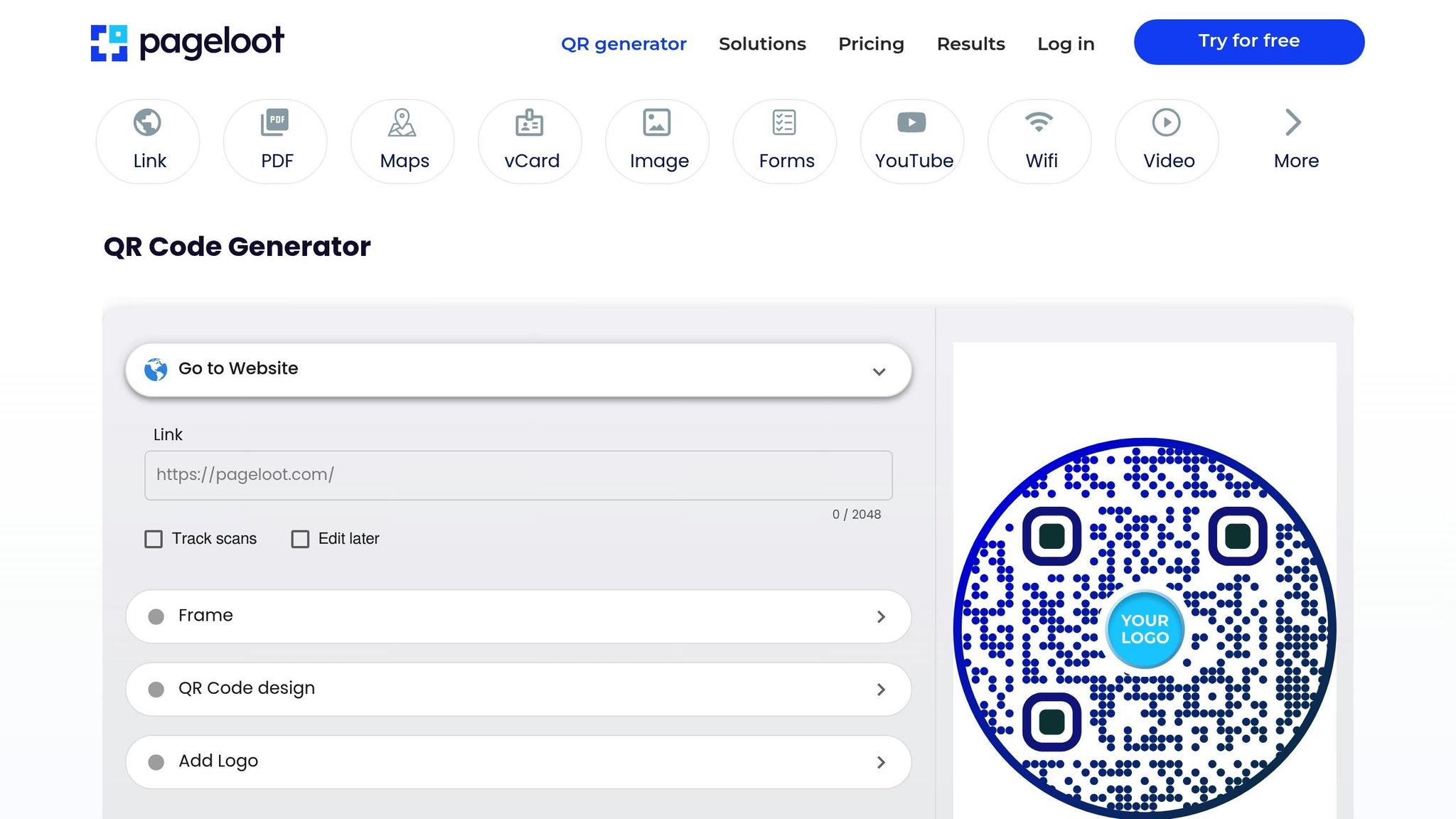
To address a wide range of needs, platforms like Pageloot offer tailored solutions. Pageloot provides free tools for generating static QR codes, including options like the Wi-Fi QR code generator, PDF QR-koodi generaator, ja vCard QR-koodi generaator. These codes are permanent and never expire, making them suitable for fixed information.
For those requiring advanced features, Pageloot’s dünaamiline QR-koodi generaator includes a 14-day free trial. It offers editable content, real-time analytics, advanced styling options, and branding tools like custom logos and colors. With support for over 25 QR code types, including Google kaardid ja Youtube, Pageloot ensures flexibility for various use cases.
The platform’s analytics dashboard provides insights into scan history, helping businesses understand user behavior and campaign performance. Whether you’re creating QR codes for visiitkaardid, lendlehed, või tootesildid, Pageloot offers templates and customization options to fit your brand.
Industry-Specific Recommendations
Different industries have unique needs when it comes to QR codes:
- Restaurants and Cafes: Static codes work well for permanent menu items or Wi-Fi access, but dynamic codes are better for menus that change seasonally or feature daily specials.
- Marketing Agencies: Dynamic codes are essential for tracking campaign performance, updating content, and generating detailed analytics reports – key for showcasing ROI to clients.
- E-kaubandus: Dynamic codes shine for product promotions and inventory management, allowing businesses to update links, track engagement, and even run A/B tests.
- Healthcare and Education: Static codes suit permanent details like facility maps or contact information, while dynamic codes are ideal for scheduling appointments or updating course materials.
- Kinnisvara: Dynamic codes on property signs and marketing materials allow real-time updates to listings, track interest levels, and provide virtual tours, saving both time and money.
The trend toward dynamic QR codes is clear. With 79% of businesses using them to deliver personalized interactions and 62% predicting increased sales by 2025 due to QR-focused strategies, it’s evident that dynamic technology is shaping the future.
Järeldus
Deciding between static and dynamic QR codes ultimately comes down to what your campaign requires. As Suhotra Roychoudhury explains:
"The main difference between a dynamic QR code and a static QR code is twofold: editability and tracking."
Static QR codes are perfect for straightforward, unchanging needs. They’re ideal for things like Wi-Fi passwords, fixed contact details, or permanent signage. Since they’re free to generate and don’t expire, they’re a practical choice for personal use or one-off campaigns where tracking isn’t a priority.
On the other hand, dynamic QR codes provide a level of flexibility that static codes simply can’t match. They’re indispensable for campaigns that require frequent updates, performance tracking, or adjustments based on customer behavior. The ability to update content without reprinting materials can save costs, and detailed analytics give you valuable insights into what’s effective and what isn’t.
Understanding these differences is key to ensuring your QR code strategy aligns with your goals.
FAQs

How do dynamic QR codes improve marketing campaigns compared to static ones?
Dynamic QR codes offer more flexibility for marketing campaigns compared to static QR codes. While static codes are permanent and can’t be modified once created, dynamic QR codes let you update the linked content or URL anytime. This means you can adjust promotions, offers, or other information on the fly – without needing to reprint the code.
Another major advantage is the ability to track important analytics. Dynamic QR codes can provide data like scan rates, user locations, and device types. This information helps businesses fine-tune their marketing strategies and better target their audience. By combining flexibility with actionable data, dynamic QR codes can make your campaigns more impactful and engaging.
What are the cost differences between dynamic and static QR codes for businesses?
Dynamic QR codes usually come with a subscription fee, which can range from $7 to over $100 per month, depending on the features included. These codes offer advanced options like the ability to edit content, track usage, and access analytics. For businesses, this means greater flexibility and deeper marketing insights.
On the other hand, static QR codes are completely free to create but come with limitations – they can’t be updated or tracked once generated. While dynamic QR codes require an initial investment, they can actually save money over time by eliminating the need to reprint materials. Plus, the data they provide can help businesses fine-tune their marketing efforts and improve customer engagement.
Can dynamic QR codes deliver personalized content based on a user’s location or device?
Dynamic QR codes have the ability to offer personalized content by adjusting based on a user’s location or device. This allows marketers to direct users to specific content that aligns with where they scan the code or the type of device they’re using.
For instance, if someone scans the code in New York, they might see promotions tailored to that area. Meanwhile, a user accessing it on a smartphone could be redirected to a mobile-optimized webpage. This adaptability creates a more engaging and relevant experience for each individual.

